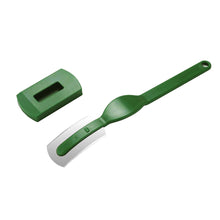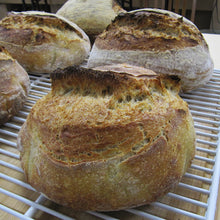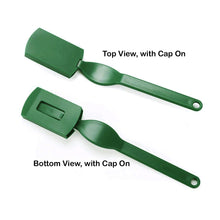Fixed Curved Razor Blade on Ergonomic Handle with Protective Cover; Green Colour
Do you know the score… or rather, how to effectively score lines on bread dough just prior to baking it so it either sprouts 'ears' or other desirable patterns to prevent unwanted bursts or blowouts as it expands? With a lame (the French word for 'blade'): a dual-sided razor-sharp cutting tool to cut lines in the formed, proofed, and newly dusted dough, just prior to placing it in the oven.
Fixed Curved Razor Blade on Ergonomic Handle with Protective Cover; Green Colour
Do you know the score… or rather, how to effectively score lines on bread dough just prior to baking it so it either sprouts 'ears' or other desirable patterns to prevent unwanted bursts or blowouts as it expands? With a lame (the French word for 'blade'): a dual-sided razor-sharp cutting tool to cut lines in the formed, proofed, and newly dusted dough, just prior to placing it in the oven.
Product Notes:
While some home bakers use actual razor blades to accomplish this, or fashion their own makeshift versions onto other sorts of handles, or buy a much fancier version with replaceable blades, this fixed blade version is specifically designed for the task and is much safer and more economical for new bakers to use. The blades are already attached to the ergonomic handle, and there is a safety cap with a locking tab to place over them, which is easy to remove or reinsert.
The 'quick and dirty' way of using this tool just to ensure there are no blowouts when baking bread is shown in the first of these three videos: the key is to commit to the cut and do each one in a single continuous line cutting about half an inch deep, with the blade at a 90 degree angle to the surface. In this particular video, it was done just with three horizontal lines, but cross, diamond, and Tic-Tac-Toe patterns are also popular options.
To create more ornate design patterns, as well, it is a good idea to have both "expansion scores" with those deeper cuts in either a square or round pattern to enclose your chosen design (such as a sheaf of wheat), and the "artistic scores" with much shallower cuts for the actual decorative pattern within that.
Finally, to get an "ear" that many like in longer loaves such as baguettes or bâtards with a flap of dough which lifts more gradually and results in a larger overall expansion or "bloom," you should hold the blade at a much more shallow angle: about 20 to 30 degrees or so, with the curve of the blade facing up (away from the loaf).
Dimensions: the cutting tool itself is 14.8 cm (5.8 inches) long, by 2.2 cm (0.9 inches) across; its cap (which fits over the razor blade when not in use for safe storage) is about 1-3/4 inches long by 1" across.
Materials: Carbon Steel blades, ABS plastic handle and cap.






